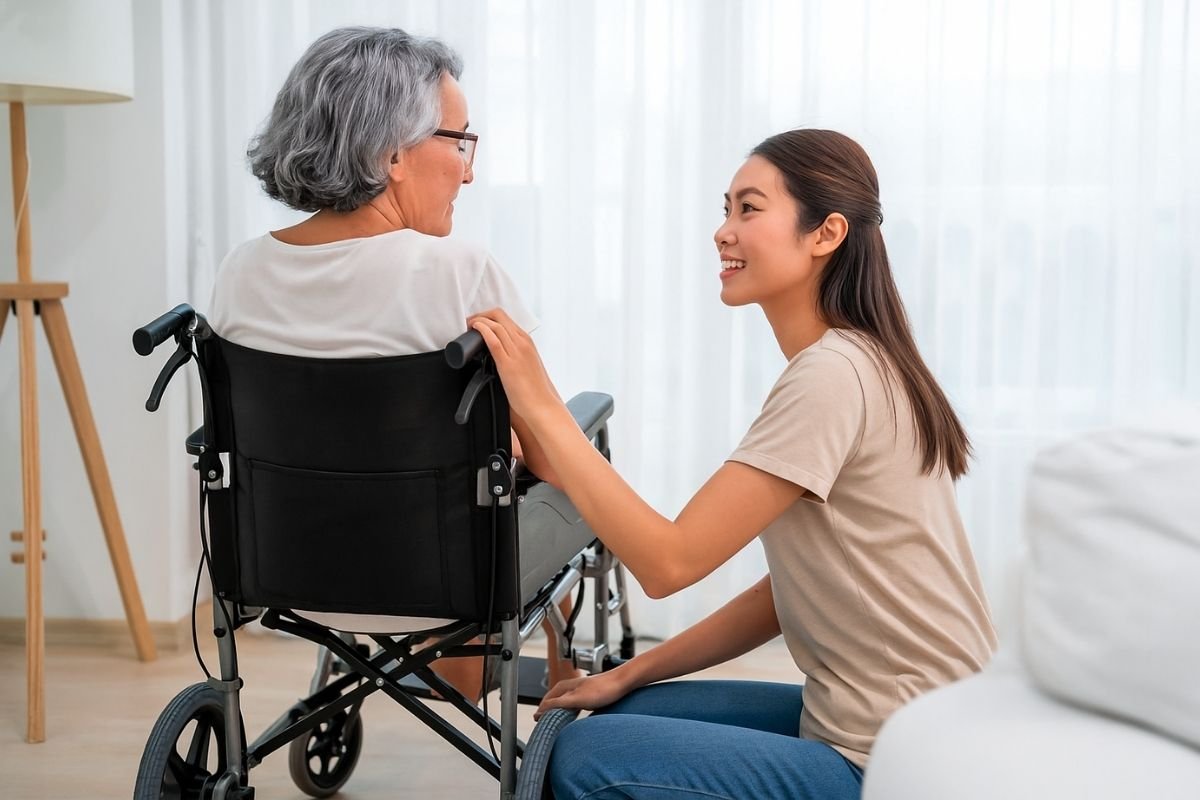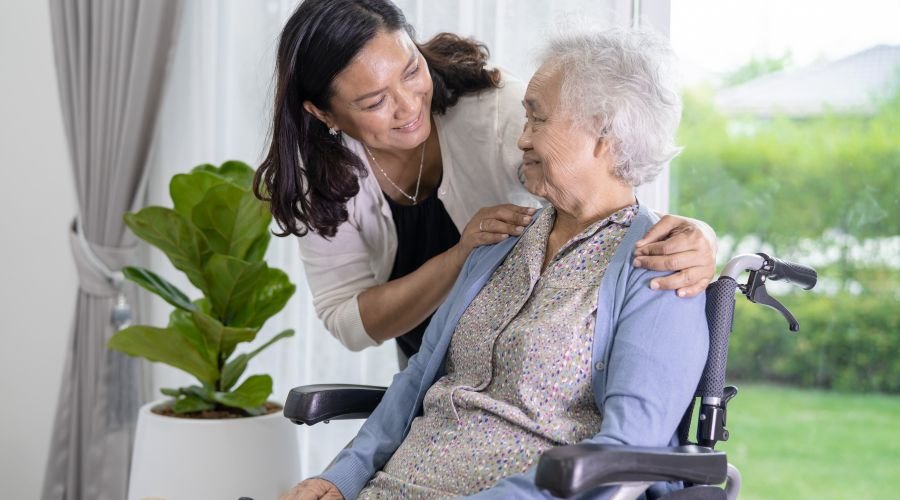Toileting and Incontinence Care
Toileting and incontinence care are crucial aspects of caregiving that directly impact the physical, emotional, and psychological well-being of individuals requiring assistance. Proper management ensures dignity, comfort, and health for the care recipient while reducing caregiver stress.
1. Health Benefits
- Prevention of Skin Issues: Regular cleaning and timely changes of incontinence products prevent skin irritation, rashes, infections, and pressure sores. These measures also reduce the risk of urinary tract infections (UTIs) caused by prolonged exposure to moisture or bacteria.
- Improved Hygiene: Maintaining cleanliness minimizes unpleasant odors and enhances overall hygiene, contributing to a healthier living environment.
2. Emotional Well-Being
- Preservation of Dignity: Sensitive handling during toileting helps maintain the individual’s self-esteem and dignity. This is especially important for older adults who may feel embarrassed or ashamed about their condition.
- Reduction in Stress: Proper care alleviates discomfort and embarrassment associated with incontinence, fostering a sense of normalcy for the care recipient.
3. Monitoring Health
- Observation of Patterns: Toileting routines provide caregivers with opportunities to monitor changes in bowel or bladder habits. Irregularities such as frequent urination, constipation, or diarrhea may indicate underlying health concerns that require medical attention.
- Early Detection of Issues: Identifying symptoms like nocturia or leakage helps caregivers address potential problems early, preventing complications.
Preparing for Toileting Assistance
Toileting assistance is a sensitive yet essential aspect of caregiving, ensuring the comfort, dignity, and health of the care recipient. Proper preparation helps streamline the process while minimizing discomfort for both the caregiver and the individual.
1. Assess the Client’s Needs
- Determine Assistance Level: Evaluate whether full assistance, supervision, or standby help is required. This depends on the individual’s mobility, strength, and cognitive abilities.
- Review Care Plan: Understand specific needs such as medical conditions (e.g., incontinence), mobility limitations, or required toileting aids like grab bars or commodes.
2. Gather Supplies
Having all necessary items ready ensures efficiency and reduces stress during toileting assistance:
- Disposable gloves for hygiene.
- Incontinence products such as adult briefs or pads.
- Cleansing wipes or washcloths for cleaning.
- Barrier creams to prevent skin irritation.
- Trash bags for safe disposal of soiled items.
- Additional aids like a portable commode, bedpan, or urinal if needed.
3. Prepare the Environment
Creating a safe and accessible environment is crucial:
- Clean and Organize: Ensure the bathroom is clean, well-lit, and free from hazards like wet floors or clutter.
- Install Safety Features: Use grab bars, non-slip mats, or raised toilet seats to enhance safety and ease of use.
- Position Equipment: Place necessary items like commode chairs or hygiene supplies within easy reach.
4. Communicate with the Client
Effective communication fosters trust and reduces anxiety:
- Explain Steps Clearly: Inform the client about each step before proceeding to avoid confusion or embarrassment.
- Respect Privacy: Close doors or use screens to maintain dignity, especially if others are present.
- Encourage Participation: Where possible, involve the individual in tasks like adjusting clothing to promote independence.
By thoughtfully assessing needs, preparing supplies, organizing the environment, and communicating effectively, caregivers can provide dignified and efficient toileting assistance. This preparation not only safeguards the client’s health but also strengthens their sense of autonomy and comfort.

Assisting with Toileting
Providing assistance with toileting is a crucial aspect of caregiving that requires sensitivity, respect, and attention to detail. This process involves several steps, each designed to ensure the client’s comfort, safety, and dignity.
1. Helping the Client to the Toilet
- When assisting a client with toileting, the caregiver’s approach depends on the individual’s mobility level. For clients who are mobile but require some assistance, the caregiver should offer physical support by providing an arm or using a gait belt to help them walk safely to the toilet. This support not only prevents falls but also instills confidence in the client.
- For clients with limited mobility, the use of assistive devices becomes essential. A wheelchair or walker can be employed to transport the individual to the bathroom safely. The caregiver should ensure that the path to the bathroom is clear of obstacles and that any necessary assistive devices are within easy reach.
2. Positioning on the Toilet
- Once at the toilet, the caregiver’s role shifts to ensuring the client is comfortably and safely positioned. This process requires careful attention to the client’s balance and stability. The caregiver should provide support by holding the client’s arm or waist during transfers, using transfer aids like a transfer board if necessary.
- When adjusting the client’s clothing, the caregiver must prioritize maintaining the individual’s dignity. This can be achieved by covering exposed areas with a towel while assisting with necessary clothing adjustments. The caregiver should move efficiently but gently, always explaining their actions to the client to reduce anxiety and maintain trust.
3. Providing Privacy
- Respecting the client’s privacy is paramount in maintaining their dignity during the toileting process. If the client is stable enough to be left alone and prefers privacy, the caregiver should step out of sight but remain nearby for safety. It’s important to reassure the client that help is available if needed. This approach allows the client to maintain a sense of independence while ensuring their safety.
4. Post-Toileting Hygiene
- After toileting, the caregiver may need to assist with personal hygiene. This task requires the use of disposable gloves and appropriate cleaning materials such as cleansing wipes or toilet paper. For female clients, it’s crucial to wipe from front to back to prevent urinary tract infections. The caregiver should be gentle and thorough, always explaining the process to the client to maintain their comfort and dignity.
5. Hand Hygiene
- The final step in the toileting process is ensuring proper hand hygiene for both the client and the caregiver. The caregiver should encourage or assist the client in washing their hands thoroughly with soap and water. If access to a sink is limited, providing hand sanitizer is an acceptable alternative. This step is crucial in preventing the spread of infections and maintaining overall health.
By following these steps and approaching the task with empathy and professionalism, caregivers can ensure that the toileting process is as comfortable and dignified as possible for their clients.
Assisting with Incontinence Care
Providing incontinence care is a vital aspect of caregiving that requires sensitivity, skill, and attention to detail. It involves several key steps to ensure the comfort, dignity, and health of the care recipient.
1. Identifying Incontinence Needs
- Regular Checks: Frequently check for soiled briefs or pads as part of routine care.
- Discreet Observation: Look for signs of discomfort or wetness without drawing attention unnecessarily.
- Gentle Inquiry: Ask sensitively if the care recipient needs assistance to maintain their dignity.
2. Changing Incontinence Products
- For Mobile Clients:
- Guide them to a private area where they can change comfortably.
- Provide assistance as needed while encouraging independence.
- For Bedridden Clients:
- Place a waterproof pad under the client to protect the bedding.
- Gently roll the individual onto their side, supporting their body throughout the movement.
- Carefully remove soiled briefs without spilling contents.
- Cleanse the area thoroughly using wipes or a washcloth.
3. Cleaning and Skin Care
- Thorough Cleaning: Use warm water and mild soap to gently clean the area, removing all traces of urine or fecal matter.
- Pat Dry: Avoid rubbing; pat the skin dry to prevent irritation.
- Apply Barrier Cream: Use prescribed creams or ointments to protect against rashes and sores, focusing on areas prone to moisture exposure.
4. Disposing of Soiled Items
- Place soiled briefs, wipes, and gloves in a sealed trash bag immediately after use to contain odors and germs.
- Consider using specialized disposal bags or odor-neutralizing products for better hygiene.
5. Repositioning After Care
- Help bedridden clients return to a comfortable position.
- Ensure clean linens are used if necessary to enhance comfort and prevent pressure sores.
Throughout this process, maintain open communication by explaining each step and involving the care recipient as much as possible. This not only reduces anxiety but also ensures that incontinence care is conducted in a way that preserves dignity and promotes comfort.

Maintaining Dignity During Care
Preserving the dignity of individuals receiving toileting and incontinence care is paramount. Caregivers play a crucial role in ensuring that these intimate care routines are conducted with respect, empathy, and sensitivity. Here are key strategies to maintain dignity during care:
Use Respectful Language
- Choose appropriate terminology: Avoid infantilizing terms like “diaper” or “potty.” Instead, use more dignified terms such as “briefs,” “pads,” or “toileting.”
- Ask for permission: Before beginning care, always request consent and explain what you’re about to do.
- Offer choices: When possible, give the care recipient options, such as “Would you prefer to use the toilet now or in a few minutes?”
Provide Privacy
- Use privacy screens: In shared rooms or open spaces, employ curtains or portable screens to create a private area for care.
- Cover exposed areas: Use towels or blankets to maintain modesty during cleaning and changing.
- Knock before entering: Always announce yourself and wait for permission before entering a bathroom or private space.
Encourage Independence
- Assess capabilities: Regularly evaluate what tasks the individual can perform independently or with minimal assistance.
- Offer supportive tools: Provide easy-to-use clothing fasteners, raised toilet seats, or grab bars to promote self-care.
- Guide rather than do: When safe, offer verbal instructions or minimal physical guidance to allow the individual to complete tasks themselves.
Respect Personal Preferences
- Learn individual routines: Pay attention to preferred times of day for toileting or specific comfort measures.
- Accommodate cultural or religious practices: Be aware of and respect any cultural or religious considerations related to personal care.
- Listen to feedback: Encourage open communication about what makes the care recipient most comfortable during care routines.
By implementing these strategies, caregivers can significantly enhance the care experience, fostering a sense of respect and preserving the individual’s sense of self-worth throughout toileting and incontinence care routines.
Special Considerations
When assisting clients with toileting or incontinence care, caregivers must adapt their approach to meet specific needs. This is especially important for individuals with cognitive impairments, those resistant to assistance, or bedridden clients. Tailored strategies ensure safety, dignity, and comfort.
1. For Clients with Cognitive Impairments (e.g., Dementia)
Clients with dementia may face challenges such as recognizing the need to use the toilet, locating it, or understanding how to use it. Caregivers should adopt a calm and reassuring approach.
- Use Simple Instructions: Provide clear and concise guidance, such as “Let’s go to the bathroom now.”
- Establish Routines: Create a predictable schedule for toileting (e.g., every two hours or after meals) to reduce anxiety and accidents.
- Environmental Adjustments:
- Install grab bars or raised toilet seats for ease of use.
- Keep the bathroom door open or place a sign with a picture of a toilet to help clients identify the location.
- Maintain Patience: Avoid rushing the client, as this can increase confusion or distress.
2. For Clients Resistant to Assistance
Resistance to toileting assistance often arises from embarrassment, fear, or a sense of lost independence. Caregivers should approach these situations with empathy and understanding.
- Explain Benefits: Gently explain why toileting is essential for their health (e.g., “This will help you feel more comfortable”).
- Offer Choices: Provide options like “Would you prefer now or in 10 minutes?” to give the client a sense of control.
- Distraction Techniques: Engage in light conversation or redirect their attention to ease resistance.
- Remain Patient: Avoid forceful behavior and allow time for the client to feel comfortable.
3. For Bedridden Clients
Toileting care for bedridden clients requires careful handling to minimize discomfort and prevent complications such as pressure sores.
- Use Assistive Tools: Employ bedpans or portable commodes placed near the bed for convenience.
- Perform Perineal Care Properly:
- Clean thoroughly using warm water and mild soap.
- Pat the skin dry gently to prevent irritation.
- Reposition Frequently: Change the client’s position every two hours to prevent pressure sores and enhance comfort.
- Apply Protective Creams: Use barrier ointments to safeguard against skin breakdown caused by prolonged exposure to moisture.
By tailoring care strategies based on individual needs and maintaining respect throughout the process, caregivers can provide effective support while preserving the client’s dignity and comfort.
Monitoring Health During Toileting/Incontinence Care
Toileting and incontinence care offer valuable opportunities for caregivers to monitor the health of individuals under their care. Observing urine and stool can provide early indicators of potential health issues, allowing for timely intervention and treatment.
Observing Urine
Caregivers should pay close attention to the appearance, odor, and frequency of urination. Healthy urine is typically clear or light yellow with no strong odor. Abnormalities to watch for include:
- Discoloration: Dark yellow or brown urine may indicate dehydration, while red or pink urine could signal the presence of blood (hematuria), which requires immediate medical attention.
- Cloudiness: Cloudy or milky urine may suggest a urinary tract infection (UTI) or the presence of pus.
- Strong or foul odor: This can also be a sign of infection or dietary changes.
- Changes in frequency or volume: Increased frequency (polyuria), decreased output (oliguria), or painful urination (dysuria) may indicate underlying issues such as kidney disorders, diabetes, or UTIs.
Caregivers should document these observations and report any abnormalities promptly to a supervisor or healthcare provider as per agency protocols. Early reporting can lead to diagnostic tests like urinalysis, which can confirm infections or other conditions.
Observing Stool
Stool characteristics are equally important indicators of gastrointestinal health. Caregivers should monitor for:
- Blood or mucus: These may indicate gastrointestinal bleeding, infections, or inflammatory bowel diseases.
- Color changes: Black, tarry stools could suggest internal bleeding, while pale stools may indicate liver or gallbladder issues.
- Consistency: Loose stools (diarrhea) may signal infections or dietary issues, while hard stools could point to constipation.
- Frequency: Significant changes in bowel habits should also be noted.
Using tools like the Bristol Stool Form Scale can help caregivers assess stool consistency and report findings accurately.
Reporting and Documentation
Caregivers must document observations systematically and communicate concerns immediately. Prompt reporting ensures that healthcare providers can take necessary actions, such as ordering diagnostic tests or adjusting care plans. By remaining vigilant during toileting and incontinence care, caregivers play a critical role in safeguarding the health and well-being of those they assist.
Safety Tips
Ensuring safety during toileting and incontinence care is essential for both caregivers and care recipients. Proper precautions not only prevent injuries but also create a secure and comfortable environment for everyone involved.
Proper Body Mechanics
- Lift and transfer safely: Always use proper body mechanics to avoid injuries. Bend at your knees, not your waist, when lifting or assisting clients. Keep your back straight and use your legs to bear the weight.
- Use assistive devices: Employ tools like gait belts, transfer boards, or Hoyer lifts to minimize strain on your body and ensure safe transfers for clients[1][4].
- Avoid unsafe grips: Do not let clients hold onto your shoulders or neck during transfers, as this can lead to injuries for both parties.
Preventing Slips and Falls
- Keep floors dry: Immediately clean up any spills or wet surfaces caused by incontinence to prevent slips.
- Declutter pathways: Ensure the pathway to the bathroom is free of obstacles, such as rugs or furniture, that could cause tripping.
- Install safety features: Add grab bars, non-slip mats, and raised toilet seats in bathrooms to provide additional stability for clients with mobility challenges.
Never Leave Bedridden Clients Unattended
- Stay nearby during care: Always remain present when assisting bedridden clients with toileting or incontinence care. Leaving them unattended increases the risk of falls or other accidents.
- Reposition frequently: After completing care, reposition bedridden clients every two hours to prevent pressure sores and enhance comfort.
Additional Safety Measures
- Ensure proper lighting: Use nightlights in bedrooms and bathrooms to help clients navigate safely during nighttime trips to the toilet.
- Encourage appropriate footwear: Advise clients to wear non-skid footwear to reduce the risk of slipping on wet surfaces.
By following these safety practices, caregivers can create a secure environment that minimizes risks and ensures the well-being of both themselves and the individuals they care for.

